Sunbird
| Sunbirds and spiderhunters | |
|---|---|
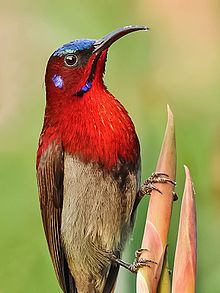
| |
| MaleVigors's sunbirdfrom Maharashtra, India | |
| Scientific classification | |
| Domain: | Eukaryota |
| Kingdom: | Animalia |
| Phylum: | Chordata |
| Class: | Aves |
| Order: | Passeriformes |
| Superfamily: | Passeroidea |
| Family: | Nectariniidae Vigors,1825 |
| Genera | |
|
16, see text | |
Sunbirdsandspiderhuntersmake up thefamilyNectariniidaeofpasserinebirds. They are small, slender passerines from theOld World,usually with downward-curved bills. Many are brightly coloured, often with iridescent feathers, particularly in the males. Many species also have especially long tail feathers. Their range extends through most of Africa to the Middle East, South Asia, South-east Asia and southern China, to Indonesia, New Guinea and northern Australia. Species diversity is highest in equatorial regions.
There are151 speciesin 16genera.Their family name is from most sunbirds feeding largely onnectar,[1]but they will also catchinsectsandspiders,especially when feeding their young. Flowers that prevent access to their nectar because of their shape (for example, very long and narrow flowers) are simply punctured at the base near the nectaries, from which the birds sip the nectar.[2]Fruitis also part of the diet of some species. Theirflightis fast and direct, thanks to their short wings.
The sunbirds have counterparts in two very distantly related groups: thehummingbirdsof the Americas and thehoneyeatersof Australia. The resemblances are due toconvergent evolutionbrought about by a similar nectar-feeding lifestyle.[3]Some sunbird species can take nectar by hovering like a hummingbird, but they usually perch to feed.
Description
[edit]
The family ranges in size from the 5-gramblack-bellied sunbirdto thespectacled spiderhunter,at about 45 grams. Like the hummingbirds, sunbirds are stronglysexually dimorphic,with the males usually brilliantly plumaged iniridescentcolours.[4]In addition to this the tails of many species are longer in the males, and overall the males are larger. Sunbirds have long thin down-curved bills and brush-tipped tubular tongues, both adaptations to their nectar feeding.[5]Thespiderhunters,of the genusArachnothera,are distinct in appearance from the other members of the family. They are typically larger than the other sunbirds, with drab brown plumage that is the same for both sexes, and long, down-curved beaks.[4]
In metabolic behaviour similar to that of Andes hummingbirds,[6]species of sunbirds that live at high altitudes or latitudes will entertorporwhile roosting at night, lowering their body temperature and entering a state of low activity and responsiveness.[4][7]
The moulting regimes of sunbirds are complex, being different in different species. Many species have no eclipse plumage, but do have juvenile plumage. Some species do show duller plumage in the off-season. In the dry months of June−August, male copper sunbirds and variable sunbirds lose much of their metallic sheen. In some instances different populations of the same species can display variation in different molting regimes.[4]
Distribution and habitat
[edit]Sunbirds are a tropicalOld Worldfamily, with representatives inAfrica,AsiaandAustralasia.In Africa they are found mostly in sub-SaharanAfricaandMadagascarbut are also distributed inEgypt.In Asia the group occurs along the coasts of theRed Seaas far north asIsrael,and along the Mediterranean as far north asBeirut,with a gap in their distribution across inland Syria and Iraq, and resuming inIran,from where the group occurs continuously as far as southernChinaandIndonesia.In Australasia the family occurs inNew Guinea,north easternAustraliaand theSolomon Islands.They are generally not found on oceanic islands, with the exception of theSeychelles.The greatest variety of species is found in Africa, where the group probably arose. Most species are sedentary or short-distanceseasonal migrants.Sunbirds occur over the entire family's range, whereas the spiderhunters are restricted toAsia.[4]
The sunbirds and spiderhunters occupy a wide range of habitats, with a majority of species being found in primary rainforest, but other habitats used by the family including disturbed secondary forest, open woodland, open scrub and savannah, coastal scrub and alpine forest. Some species have readily adapted to human modified landscapes such as plantations, gardens and agricultural land. Many species are able to occupy a wide range of habitats from sea level to 4900 m.[4]
Behaviour and ecology
[edit]Sunbird are activediurnalbirds that generally occur in pairs or occasionally in small family groups. A few species occasionally gather in larger groups, and sunbird will join with other birds tomobpotential predators, although sunbirds will also aggressively target other species, even if they are not predators, when defending theirterritories.[4]
Breeding
[edit]
Sunbirds that breed outside of the equatorial regions are mostly seasonal breeders, with the majority of them breeding in thewet season.This timing reflects the increased availability of insect prey for the growing young. Where species, like thebuff-throated sunbird,breed in the dry season, it is thought to be associated with the flowering of favoured food plants. Species of sunbird in the equatorial areas breed throughout the year. They are generallymonogamousand often territorial, although a few species of sunbirds havelekkingbehaviour.[8] Thenestsof sunbirds are generally purse-shaped, enclosed, suspended from thin branches with generous use of spiderweb. The nests of the spiderhunters are different, both from the sunbirds and in some cases from each other. Some, like thelittle spiderhunter,are small woven cups attached to the underside of large leaves; that of theyellow-eared spiderhunteris similarly attached but is a long tube. The nests of spiderhunters are inconspicuous, in contrast to those of the other sunbirds which are more visible. In most species the female alone constructs the nest. Up to four eggs are laid. The female builds the nest and incubates the eggs alone, although the male assists in rearing the nestlings.[9]In the spiderhunters both sexes help to incubate the eggs.[9]The nests of sunbirds and spiderhunters are often targeted bybrood parasitessuch ascuckoosandhoneyguides.
Pollination
[edit]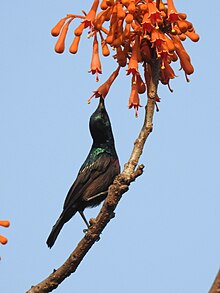
As nectar is a primary food source for sunbirds, they are importantpollinatorsin African ecosystems. Sunbird-pollinated flowers are typically long, tubular, and red-to-orange in colour, showing convergent evolution with manyhummingbird-pollinated flowers in the Americas.[10]A key difference is that sunbirds cannot hover, so sunbird-pollinated flowers andinflorescencesare typically sturdier than hummingbird-pollinated flowers, with an appropriate landing spot from which the bird can feed.[11][12]Sunbirds are critical pollinators for many iconic African plants, includingproteas,[13]aloes,[14]Erica,[12]Erythrinacoral trees,[10]andbird-of-paradiseflowers.[15]Specialization on sunbirds vs other pollinators is thought to have contributed to plantspeciation,including the exceptionally high floral diversity in southern Africa.[16][17]
Relationship with humans
[edit]Overall the family has fared better than many others, with only seven species considered to bethreatenedwithextinction.Most species are fairly resistant to changes in habitat, and while attractive the family is not sought after by the cagebird trade, as they have what is considered an unpleasant song and are tricky to keep alive. Sunbirds are considered attractive birds and readily enter gardens where flowering plants are planted to attract them. There are a few negative interactions, for example thescarlet-chested sunbirdis considered a pest in cocoa plantations as it spreads parasiticmistletoes.[4]
List of genera
[edit]The family contains 151 species divided into 16 genera:[18]For more detail, seelist of sunbird species.
| Image | Genus | Species |
|---|---|---|
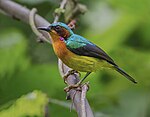
|
ChalcopariaCabanis, 1851 |
|

|
DeleornisWolters, 1977 |
|
 |
AnthreptesSwainson, 1832 |
15 species:
|
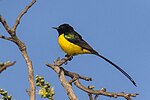 |
HedydipnaCabanis, 1851 |
|
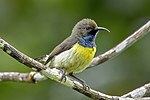 |
AnabathmisReichenow, 1905 |
|

|
DreptesIlliger, 1811 |
|
 |
AnthobaphesCabanis, 1851 |
|
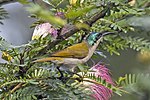 |
CyanomitraReichenbach, 1853 |
|
 |
ChalcomitraReichenbach, 1853 |
|
 |
LeptocomaCabanis, 1851 |
|
 |
NectariniaIlliger, 1811 |
|
 |
DrepanorhynchusFischer & Reichenow, 1884 |
|
 |
CinnyrisCuvier, 1816 |
63 species:
|
 |
AethopygaCabanis, 1851 |
22 species:
|
 |
KurochkinegrammaKashain, 1978 |
|
 |
ArachnotheraTemminck, 1826 |
13 species:
|
References
[edit]- ^Jobling, James A. (2010).The Helm Dictionary of Scientific Bird Names.London, England, UK: Christopher Helm. p. 267.ISBN978-1-4081-2501-4.
- ^Geerts, S.; Pauw, A. (2009)."Hyper-specialization for long-billed bird pollination in a guild of South African plants: the Malachite Sunbird pollination syndrome".South African Journal of Botany.75(4): 699–706.doi:10.1016/j.sajb.2009.08.001.
- ^Prinzinger, R.; Schafer T.; Schuchmann K.L. (March 1992). "Energy metabolism, respiratory quotient and breathing parameters in two convergent small bird species: the fork-tailed sunbirdAethopyga christinae(Nectariniidae) and the Chilean HummingbirdSephanoides sephanoides(Trochilidae) ".Journal of Thermal Biology.17(2): 71–79.Bibcode:1992JTBio..17...71P.doi:10.1016/0306-4565(92)90001-V.
- ^abcdefghCheke, Robert; Mann, Clive (2008). "Family Nectariniidae (Sunbirds)". In del Hoyo, Josep; Elliott, Andrew; Christie, David (eds.).Handbook of the Birds of the World, Volume 13: Penduline-tits to Shrikes.Barcelona: Lynx Editions. pp. 196–243.ISBN978-84-96553-45-3.
- ^Paton, D. C.; Collins, B. G. (1989). "Bills and tongues of nectar-feeding birds: A review of morphology, function and performance, with intercontinental comparisons".Australian Journal of Ecology.14(4): 473–506.doi:10.1111/j.1442-9993.1989.tb01457.x.ISSN1442-9993.
- ^Altshuler, Douglas L.; Dudley, Robert (15 August 2002)."The ecological and evolutionary interface of hummingbird flight physiology".Journal of Experimental Biology.205(16): 2325–2336.doi:10.1242/jeb.205.16.2325.PMID12124359– via jeb.biologists.org.
- ^Downs, Colleen; Mark Brown (January 2002)."Nocturnal Heterothermy And Torpor In The Malachite Sunbird (Nectarinia famosa) ".Auk.119(1): 251–260.doi:10.1642/0004-8038(2002)119[0251:NHATIT]2.0.CO;2.S2CID85925616.
- ^Elliott, Andrew (2008).Handbook of the Birds of the World.Lynx Edicions.ISBN978-84-96553-45-3.
- ^abLindsey, Terence (1991). Forshaw, Joseph (ed.).Encyclopaedia of Animals: Birds.London: Merehurst Press. p. 207.ISBN978-1-85391-186-6.
- ^abBruneau, Anne (1997)."Evolution and homology of bird pollination syndromes in Erythrina (Leguminosae)".American Journal of Botany.84(1): 54–71.doi:10.2307/2445883.ISSN1537-2197.JSTOR2445883.
- ^Barrett, Spencer C. H.; Cole, William W.; Anderson, Bruce (May 2005). "Botany: Specialized bird perch aids cross-pollination".Nature.435(7038): 41–42.Bibcode:2005Natur.435...41A.doi:10.1038/435041a.ISSN1476-4687.PMID15875009.S2CID25020534.
- ^abSiegfried, W. R.; Rebelo, A. G.; Prŷs-Jones, R. P.; Prys-Jones, R. P. (1985). "Stem Thickness of Erica Plants in Relation to Avian Pollination".Oikos.45(1): 153.Bibcode:1985Oikos..45..153S.doi:10.2307/3565234.JSTOR3565234.
- ^Hargreaves, Anna L.; Johnson, Steven D.; Nol, Erica (2004). "Do floral syndromes predict specialization in plant pollination systems? An experimental test in an" ornithophilous "African Protea".Oecologia.140(2): 295–301.Bibcode:2004Oecol.140..295H.doi:10.1007/s00442-004-1495-5.ISSN1432-1939.PMID15168105.S2CID24426457.
- ^Ratsirarson, J (1995)."Pollination ecology of Aloe divaricata, Berger (Liliaceae): an endemic plant species of south-west Madagascar".South African Journal of Botany.61(5): 249–252.doi:10.1016/S0254-6299(15)30531-7.
- ^Frost, S. K.; Frost, P. G. H. (1981). "Sunbird pollination of Strelitzia nicolai".Oecologia.49(3): 379–384.Bibcode:1981Oecol..49..379F.doi:10.1007/BF00347603.ISSN0029-8549.PMID28310001.S2CID11735363.
- ^Valente, Luis M.; Manning, John C.; Goldblatt, Peter; Vargas, Pablo (2012-07-01). "Did Pollination Shifts Drive Diversification in Southern African Gladiolus? Evaluating the Model of Pollinator-Driven Speciation".The American Naturalist.180(1): 83–98.doi:10.1086/666003.ISSN0003-0147.PMID22673653.S2CID5989519.
- ^Johnson Steven D. (2010-02-12)."The pollination niche and its role in the diversification and maintenance of the southern African flora".Philosophical Transactions of the Royal Society B: Biological Sciences.365(1539): 499–516.doi:10.1098/rstb.2009.0243.PMC2838267.PMID20047876.
- ^Gill, Frank;Donsker, David;Rasmussen, Pamela,eds. (December 2023)."Dippers, leafbirds, flowerpeckers, sunbirds".IOC World Bird List Version 14.1.International Ornithologists' Union.Retrieved22 January2024.
External links
[edit]- Sunbird videoson the Internet Bird Collection
